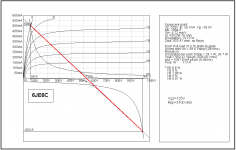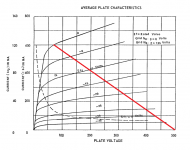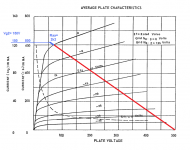Good evening everyone,
It's been quite a while since I've been to this forum and quite a while since I played with tubes. I'm looking at doing a PP w/6JE6C's. My intention is 525 v on the plate and 200 v on the screen. My question comes down to using the correct output transformer. The chassis I am using has a 2.2K, 125 Watt transformer on it. My gut tells me 2.2K might be a bit low, would like to hear opinions on this.
Thanks,
Ray
It's been quite a while since I've been to this forum and quite a while since I played with tubes. I'm looking at doing a PP w/6JE6C's. My intention is 525 v on the plate and 200 v on the screen. My question comes down to using the correct output transformer. The chassis I am using has a 2.2K, 125 Watt transformer on it. My gut tells me 2.2K might be a bit low, would like to hear opinions on this.
Thanks,
Ray
Attachments
Thank you Sy. I moved to Nashville some 2 years ago and finally got settled. So, it sounds like I should drop G2 from 200v to 125v.
Ray, great to see you back!
Looking at the g2 = 125V curves, that load impedance seems pretty reasonable.
2k2 is 550R on the class B loadline.. that loadline will cross Ia=525v/550v=about 950mA at Vak=0v. Unless you're doing class AB2, looks like initial plan of using Vg2=200v is more suited.
6JE6 is equiv to 6LQ6. Here is 6LQ6 datasheet with varying Vg2 curve at Vg1=0v. It goes to Vg2=150v only but you can eyeball it and estimate that it needs Vg2=200v to stay in Class AB1.
http://www.nj7p.info/Tubes/PDFs/Frank/135-GE/6LQ6.pdf
6JE6 is equiv to 6LQ6. Here is 6LQ6 datasheet with varying Vg2 curve at Vg1=0v. It goes to Vg2=150v only but you can eyeball it and estimate that it needs Vg2=200v to stay in Class AB1.
http://www.nj7p.info/Tubes/PDFs/Frank/135-GE/6LQ6.pdf
If you adapt the vertical scale for Vg2=150V the same loadline is then for Raa= 2k2Ray, here's the loadline I originally drew. That shows a 2800 ohm load. Probably close enough, especially considering that your speakers will not have anything vaguely approaching a flat impedance.
Mona
Attachments
Ray,
While you were moving south, I was moving north. Like you I'm still settling in and currently rebuilding my lab from scratch since moving 36 years of accumulated stuff 1200 miles within a 3 week time frame wasn't economical, or even possible. Was on a road trip for the last 2 weeks (back to Florida) so I haven't been here much.
Two things limit the maximum power output of a sweep tube into a given load and B+ voltage. Peak cathode current capability and plate dissipation rating.
I have never used the 6JE6C or any of the compatible tubes due to their relative scarcity and high price. Looking at the curves, I see another problem. The peak cathode current is 1200 mA. You ideally want a tube that can reach the peak cathode current with zero G1 volts, a sane G2 voltage and near zero plate voltage. Under a peak or transient situation (a drum hit for example) the tube should reach saturation at the peak to achieve best efficiency. Good efficiency reduces the power dissipated in the tube as heat.
The easiest way to guesstimate how things will work is to see if your chosen tube, transformer and supply voltage will work, and if you can achieve an acceptable power output, is to figure out the peak requirements.
Your OPT is 2.2K ohms. That is 550 ohms per side. Assuming Class AB1, you will drive G1 to zero volts at the peak current.
Starting at 125 volts on the screen, you can find the knee on the screen curves (looking at a 6LQ6 chart) at about 40 volts. Assuming 525 volts B+ and 40 volts drop in a saturated tube, there will be 485 volts across the OPT, which is 550 ohms, drawing 880 mA. From the 125 volt screen (G1=0) curve, the 6LQ6 can only support about 550 mA in saturation, so the tube drop will be much higher than 40 volts. You can iterate this out to find the actual tube drop, but it is much too high.
Trying 150 volts on the screen the knee is again about 40 volts, and again we cant get to 880 mA under these conditions.
Extrapolating the curves out to 175 volts on the screen yields about 850 mA which is close, so 180 to 190 volts may be the right choice. I would avoid using a screen voltage any higher than needed for the power level desired. My experience has shown that with few exceptions most sweep tubes like 150 to 175 volts on G2. Some older designs can benefit from a few more volts, but I have never needed over 200 volts on a Class AB1 pentode sweep tube amp.
That said even 175 volts on a pair of 6JE6C's will probably produce more power than your OPT's can eat.
How it will all sound is another matter that is really hard to predict. Assuming 8 ohm speakers, and an 8 ohm secondary on the OPT, If your speakers have significant dips in impedance below 8 ohms, especially in the frequency range where your music has the most energy, these dips will be reflected into the true load the tubes will see. The tubes may struggle to feed the load if you ask the amp for significant power output. Some negative feedback can help, but it wont cure tubes that can't pump the peak currents drawn by the load.
I have used 2.5K ohms with slightly bigger tubes (35LR6, 36LW6) to make big power (250 WPC) on 650 volts, but tubes in the 6JE6 size range struggle (red plate on continuous sine wave) at this plate voltage. Distortion was lower and the tubes were much happier with 3.3K Edcors and I still got almost 150 WPC. They may do OK on 525 volts, but the only sure way to tell is to build it.
Note that sweep tube amps in this power level NEED a regulated screen voltage source and should have a regulated bias supply. I choose to make the screen supply adjustable from about 125 to 180 volts, but find that most big tubes like 150 volts.
I mentioned the maximum plate dissipation rating as a secondary limiting factor. Most HiFi amps seldom see full power, and on normal music the average power is less than 10% of full power, so the dissipation limit is only an issue with high plate voltages. At B+ in the 600 to 750 volt range the idle current needed to eliminate crossover distortion starts to become most of the tube's dissipation with smallish tubes. If the amp will see continuous sine wave duty, or say pump out dance music at the clipping level, then tube dissipation needs to be looked at.
While you were moving south, I was moving north. Like you I'm still settling in and currently rebuilding my lab from scratch since moving 36 years of accumulated stuff 1200 miles within a 3 week time frame wasn't economical, or even possible. Was on a road trip for the last 2 weeks (back to Florida) so I haven't been here much.
Two things limit the maximum power output of a sweep tube into a given load and B+ voltage. Peak cathode current capability and plate dissipation rating.
I have never used the 6JE6C or any of the compatible tubes due to their relative scarcity and high price. Looking at the curves, I see another problem. The peak cathode current is 1200 mA. You ideally want a tube that can reach the peak cathode current with zero G1 volts, a sane G2 voltage and near zero plate voltage. Under a peak or transient situation (a drum hit for example) the tube should reach saturation at the peak to achieve best efficiency. Good efficiency reduces the power dissipated in the tube as heat.
The easiest way to guesstimate how things will work is to see if your chosen tube, transformer and supply voltage will work, and if you can achieve an acceptable power output, is to figure out the peak requirements.
Your OPT is 2.2K ohms. That is 550 ohms per side. Assuming Class AB1, you will drive G1 to zero volts at the peak current.
Starting at 125 volts on the screen, you can find the knee on the screen curves (looking at a 6LQ6 chart) at about 40 volts. Assuming 525 volts B+ and 40 volts drop in a saturated tube, there will be 485 volts across the OPT, which is 550 ohms, drawing 880 mA. From the 125 volt screen (G1=0) curve, the 6LQ6 can only support about 550 mA in saturation, so the tube drop will be much higher than 40 volts. You can iterate this out to find the actual tube drop, but it is much too high.
Trying 150 volts on the screen the knee is again about 40 volts, and again we cant get to 880 mA under these conditions.
Extrapolating the curves out to 175 volts on the screen yields about 850 mA which is close, so 180 to 190 volts may be the right choice. I would avoid using a screen voltage any higher than needed for the power level desired. My experience has shown that with few exceptions most sweep tubes like 150 to 175 volts on G2. Some older designs can benefit from a few more volts, but I have never needed over 200 volts on a Class AB1 pentode sweep tube amp.
That said even 175 volts on a pair of 6JE6C's will probably produce more power than your OPT's can eat.
How it will all sound is another matter that is really hard to predict. Assuming 8 ohm speakers, and an 8 ohm secondary on the OPT, If your speakers have significant dips in impedance below 8 ohms, especially in the frequency range where your music has the most energy, these dips will be reflected into the true load the tubes will see. The tubes may struggle to feed the load if you ask the amp for significant power output. Some negative feedback can help, but it wont cure tubes that can't pump the peak currents drawn by the load.
I have used 2.5K ohms with slightly bigger tubes (35LR6, 36LW6) to make big power (250 WPC) on 650 volts, but tubes in the 6JE6 size range struggle (red plate on continuous sine wave) at this plate voltage. Distortion was lower and the tubes were much happier with 3.3K Edcors and I still got almost 150 WPC. They may do OK on 525 volts, but the only sure way to tell is to build it.
Note that sweep tube amps in this power level NEED a regulated screen voltage source and should have a regulated bias supply. I choose to make the screen supply adjustable from about 125 to 180 volts, but find that most big tubes like 150 volts.
I mentioned the maximum plate dissipation rating as a secondary limiting factor. Most HiFi amps seldom see full power, and on normal music the average power is less than 10% of full power, so the dissipation limit is only an issue with high plate voltages. At B+ in the 600 to 750 volt range the idle current needed to eliminate crossover distortion starts to become most of the tube's dissipation with smallish tubes. If the amp will see continuous sine wave duty, or say pump out dance music at the clipping level, then tube dissipation needs to be looked at.
- Status
- This old topic is closed. If you want to reopen this topic, contact a moderator using the "Report Post" button.
- Home
- Amplifiers
- Tubes / Valves
- Advise on output transformer vs PP tubes


